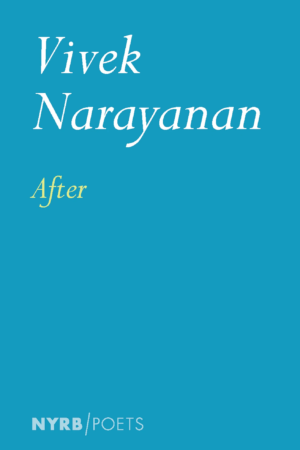After
by Vivek Narayanan
reviewed by Kevin McGrath
Vivek Narayanan, one of the most distinguished Indian poets of today, has with this remarkable book drawn upon an Indian heroic song of the late Bronze Age, Rāmāyana, and transferred the ancient virtues and poetic being of that epic to the twenty-first century. Such is the foundation of the reimagined narrative in After.
The author accomplishes this act of translation from a premodern poetic culture to that of the present day via an act of “inspiration,” allowing the original text—in a contemporary English abridged translation—to become a work of “re–animation” as modern free verse. As the author puts it, his method is “open and evolving,” achieved through a “critical conversation with Valmiki,” the putative prime poet of the Sanskrit epic. Narayanan claims that his work is a “reinvention or rewiring” of the primary text and that this method will “make [the] source and its possibilities come fully alive.” Here, the author continues a Western poetic tradition first practiced in the early twentieth century by Ezra Pound.
Narayanan enters into the nomenclature of the present century and draws upon characters of today in a manner similar to Derek Walcott’s rendering of Homeric poetry in a West Indian milieu with Omeros, or Christopher Logue’s modernist interpretation of the Iliad in War Music. The moral and emotional crises in the ancient narrative still exist, but they are delivered with contemporary language and metaphor: guerrillas, cell phones, censorship, cops, Maoists, motorcycles, and guns. The violence of warfare and of urban conflict inhabit the lines of this modern work, just as Rama’s armies and the daemon forces of Lanka once joined in armed contention in the original. In the ancient epic, however, warfare was made beautiful via simile, and the vehemence and cruelty of fighting were omitted. This is not the case with Narayanan’s poem. Here, in fact, the author makes much of the violence that currently occurs in South Asia, on both a state and a communal level.
So what is the moral of this book? What is the author offering to the reader by redacting ancient song traditions into twenty-first-century speech and prose? There is little formal sonority to the lines, which means that the tonal and musical quality of the ancient slokas, the Sanskrit verse form, are forsaken. The verbal formulations that once structured the poem are lost, and what we have in After is a critique of how callous and brutal life can be today. It is as if the firmly organized society of the late Bronze Age has been displaced by a world in which ostensibly democratic states are sites of vicious struggle, where the migrant poor—the impoverished and undocumented—are tormented and suffer. The ethical world of After is completely unlike the dharmically hierarchical world of the Rāmāyana. The universal causality at play in these two models of narrative are completely unlike each other, and it is only the rough typology of characterization in the older poem that remains. Yet this poem of Narayanan has great political force for a modern and activist readership, both Asian and Western.
Several poets and prose writers in India today have performed similar work with their redoing of the Mahābhārata, a still-more-antique poem that visualizes rivalrous conflict between clans and families. In this sense, After is fully within the present-day national tradition. Shashi Tharoor’s The Great Indian Novel is the best example of this kind of literary movement where ancient values receive current reformulation.
Ultimately, the title After refers to language itself, the “deathless instrument of the soul.” As the author remarks at the end of his work, there is “no sea except what swims in it,” and it is this world—not the ocean of poetry but its constantly reinvented creatures—that revives human struggle toward literary meaning. The endless conduct and confrontation of human outrage and violation becomes the action in Narayanan’s tour de force, radicalizing our apprehension of beauty.
Published on April 12, 2022

